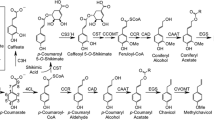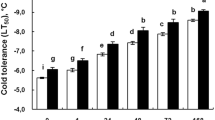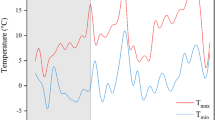Abstract
In creating cold tolerance, plant cells induce cascades of alterations in metabolic pathways including, phenylpropanoid pathway, the activity of antioxidant enzymes and the regulation of gene expression. In this study, some such responses were comparatively studied in two chickpea (Cicer arietinum L.) genotypes, Kabuli (Sel96Th11439) and Desi (4322) under control (23°C) and days 2 and 4 after exposing the seedlings to cold stress (4°C) in acclimated and non-acclimated plants. Under cold, the contents of hydrogen peroxide (H2O2) in Kabuli plants were lower than that of Desi plants particularly in acclimated plants. In acclimated plants, antioxidants and antioxidant enzymes such as ascorbate peroxidase (APX) and guaiacol peroxidase (GPX) and total phenolic compounds had an important role in creating greater cold tolerance. Under these conditions, a high transcription level of phenylalanine ammonia-lyase (CaPAL), cinnamyl alcohol dehydrogenase (CaCAD) and CaLaccase genes was detected in acclimated plants which was accompanied with an increase in lignin contents. The above results indicate the crucial role of phenylpropanoid pathway in creating cold tolerance particularly in Kabuli chickpea plants, which leads to decreased levels of injuries and increased capacity in defense systems.
Similar content being viewed by others
Abbreviations
- APX:
-
ascorbate peroxidase
- CAD:
-
cinnamyl alcohol dehydrogenase
- GPX:
-
guaiacol peroxidase
References
Gill, S.S. and Tuteja, N., Reactive oxygen species and antioxidant machinery in abiotic stress tolerance in crop plants, Plant Physiol. Biochem., 2010, vol. 48, pp. 909–930.
Kazemi S.S., Shahandashti, S.S., Maali-Amiri, R., Zeinali, H., and Ramezanpour, S.S., Change in membrane fatty acid compositions and cold-induced responses in chickpea, Mol. Biol. Rep., 2013, vol. 40, pp. 893–903.
Ramakrishna, A. and Ravishankar, G.A., Influence of abiotic stress signals on secondary metabolites in plants, Plant Signal. Behav., 2011, vol. 6, pp. 1720–1731.
Páldi, K., Rácz, I., Szigeti, Z., and Rudnóy, S., S-methylmethionine alleviates the cold stress by protection of the photosynthetic apparatus and stimulation of the phenylpropanoid pathway, Biol. Plant., 2014, vol. 58, pp. 189–194.
Iijima, Y., Rikanati, R.D., Fridman, E., Gang, D.R., Bar, E., Lewinsohn, E., and Pichersky, E., The biochemical and molecular basis for the divergent in the biosynthesis of terpenes and phenylpropenes in the peltate gland of three cultivars of basil, Plant Physiol., 2004, vol. 136, pp. 3724–3734.
Weng, J.K. and Chapple, C., The origin and evolution of lignin biosynthesis, New Phytol., 2010, vol. 187, pp. 273–285.
Ali, M.B. and McNear, D.H., Induced transcriptional profiling of phenylpropanoid pathway genes increased flavonoid and lignin content in Arabidopsis leaves in response to microbial products, BMC Plant Biol., 2014, vol. 14, p. 84.
Wen, P.F., Chen, J.Y., Wan, S.B., Kong, W.F., Zhang, P., and Wang, W., Salicylic acid activates phenylalanine ammonia-lyase in grape berry in response to high temperature stress, J. Plant Growth Regul., 2008, vol. 55, pp. 1–10.
Kazemi-Shahandashti, S.S., Maali-Amiri, R., Zeinali, H., Khazaei, M., Talei, A., and Ramezanpour, S.S., Effect of short-term cold stress on oxidative damage and transcript accumulation of defense-related genes in chickpea seedlings, J. Plant Physiol., 2014, vol. 171, pp. 1106–1116.
Heidarvand, L. and Maali-Amiri, R., Physio-biochemical and proteome analysis of chickpea in early phases of cold stress, J. Plant Physiol., 2013, vol. 170, pp. 459–469.
Nejadsadeghi, L., Maali-Amiri, R., Zeinali, H., Ramezanpour, S., and Sadeghzade, B., Comparative analysis of physio-biochemical responses to cold stress in tetraploid and hexaploid wheat, Cell Biochem. Biophys., 2014, vol. 70, pp. 399–408.
Ma, B., Gao, L., Zhang, H., Cui, J., and Shen, Z., Aluminum-induced oxidative stress and changes in antioxidant defenses in the roots of rice varieties differing in Al tolerance, Plant Cell Rep., 2012, vol. 31, pp. 687–696.
Barcel, A.R., Peroxidase and not laccase is the enzyme responsible for cell wall lignification in the secondary thickening of xylem vessels in Lupinus, Protoplasma, 1995, vol. 186, pp. 41–44.
Nazari, M.R., Maali-Amiri, R., Mehraban, F.H., and Khaneghah, H.Z., Change in antioxidant responses against oxidative damage in black chickpea following cold acclimation, Russ. J. Plant Physiol., 2012, vol. 59, pp. 183–189.
Mohammadi, R., Maali-Amiri, R., and Mantri, N.L., Effect of TiO2 nanoparticles on oxidative damage and antioxidant defense systems in chickpea seedlings during cold stress, Russ. J. Plant Physiol., 2014, vol. 61, pp. 768–775.
Nayyar, H., Bains, T.S., and Sanjeev, K., Chilling stressed chickpea seedlings: effect of cold acclimation, calcium and abscisic acid on cryoprotective solutes and oxidative damage, Environ. Exp. Bot., 2005, vol. 54, pp. 275–285.
Bradford, M.M., Rapid and sensitive method for the quantitation of microgram quantities of protein utilizing the principle of protein–dye binding, Anal. Biochem., 1976, vol. 72, pp. 248–254.
Singleton, V.L. and Rossi, J.A., Colorimetry of total phenolic with phosphomolybdic–phosphotungstic acid reagents, Am. J. Enol. Vitic., 1965, vol. 16, pp. 144–158.
Livak, K.J. and Schmittgen, T.D., Analysis of relative gene expression data using real-time quantitative PCR and the 2–CT method, Methods, 2001, vol. 25, pp. 402–408.
Rivero, R.M., Ruiz, J.M., Garca, P.C., LopezLefebre, L.R., Sanchez, E., and Romero, L., Resistance to cold and heat stress: accumulation of phenolic compounds in tomato and watermelon plants, Plant Sci., 2001, vol. 160, pp. 315–321.
Lianopoulou, V., Bosabalidis, A.M., Patakas, A., Lazari, D., and Panteris, E., Effects of chilling stress on leaf morphology, anatomy, ultrastructure, gas exchange, and essential oils in the seasonally dimorphic plant Teucrium polium (Lamiaceae), Acta Physiol. Plant., 2014, vol. 36, pp. 2271–2281.
Sakihama, Y. and Yamasaki, H., Lipid peroxidation induced by phenolics in conjunction with aluminum ions, Biol. Plant., 2002, vol. 45, pp. 249–254.
Moura, J.C.M.S., Bonine, C.A.V., De Oliveira, Fernandes J., Viana, J., Dornelas, M.C., and Mazzafera, P., Abiotic and biotic stresses and changes in the lignin content and composition in plants, J. Integr. Plant Biol., 2010, vol. 52, pp. 360–376.
Hausman, J.F., Evers, D., Thiellement, H., and Jouve, L., Compared responses of poplar cuttings and in vitro raised shoots to short-term chilling treatments, Plant Cell Rep., 2000, vol. 19, pp. 954–960.
Janska, A., Aprile, A., Zamecnik, J., Cattivelli, L., and Ovesna, J., Transcriptional responses of winter barley to cold indicate nucleosome remodelling as a specific feature of crown tissues, Funct. Integr. Genomics, 2011, vol. 11, pp. 307–325.
Sasaki, M., Yamamoto, Y., and Matsumoto, H., Lignin deposition induced by aluminum in wheat (Triticum aestivum) roots, Physiol. Plant., 1996, vol. 96, pp. 193–198.
Lee, B.R., Kim, K.Y., Jung, W.J., Avice, J.C., Ourry, A., and Kim, T.H., Peroxidases and lignification in relation to the intensity of water-deficit stress in white clover (Trifolium repens L.), J. Exp. Bot., 2007, vol. 58, pp. 1271–1279.
Andersson-Gunners, S., Mellerowicz, E.J., Love, J., Segerman, B., Ohmiya, Y., Coutinho, P.M., Nilsson, P., Henrissat, B., Moritz, T., and Sundberg, B., Biosynthesis of cellulose-enriched tension wood in Populus tremula: global analysis of transcripts and metabolites identifies biochemical and developmental regulators in secondary wall biosynthesis, Plant J., 2006, vol. 45, pp. 144–165.
Blee, K.A., Choi, J.W., O’Connell, A.P., Schuch, W., Lewis, N.G., and Bolwell, G.P., A lignin-specific peroxidase in tobacco whose antisense suppression leads to vascular tissue modification, Phytochemistry, 2003, vol. 64, pp. 163–176.
Author information
Authors and Affiliations
Corresponding author
Additional information
The article is published in the original.
Rights and permissions
About this article
Cite this article
Khaledian, Y., Maali-Amiri, R. & Talei, A. Phenylpropanoid and antioxidant changes in chickpea plants during cold stress. Russ J Plant Physiol 62, 772–778 (2015). https://doi.org/10.1134/S1021443715060102
Received:
Published:
Issue Date:
DOI: https://doi.org/10.1134/S1021443715060102




